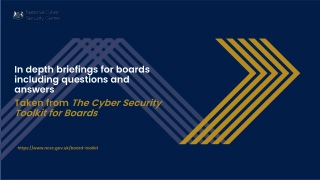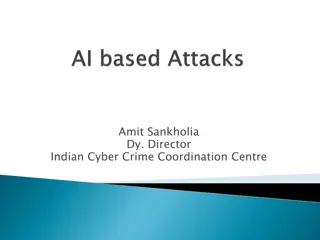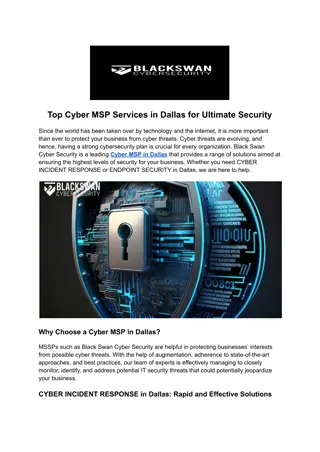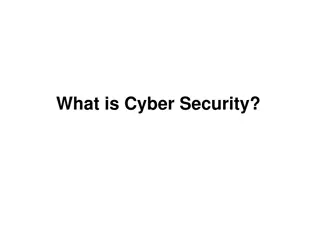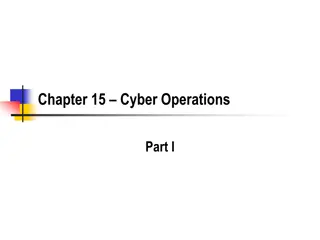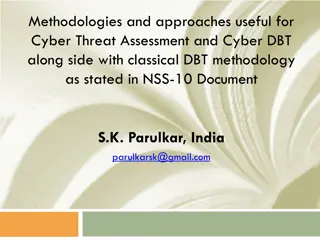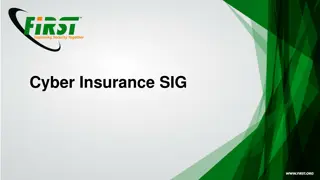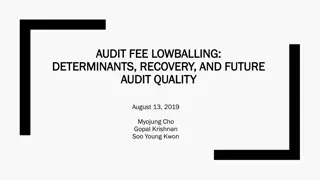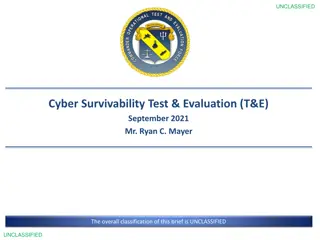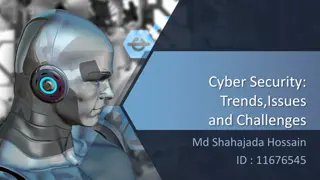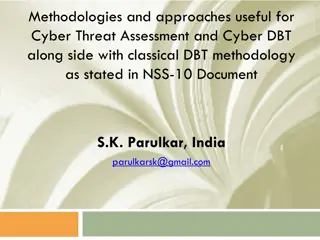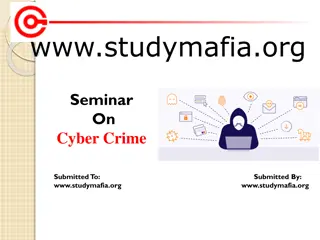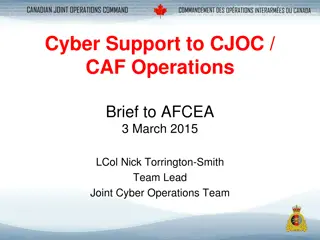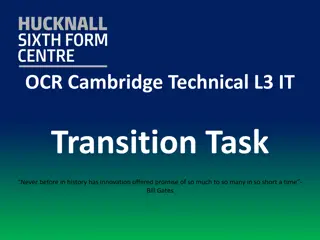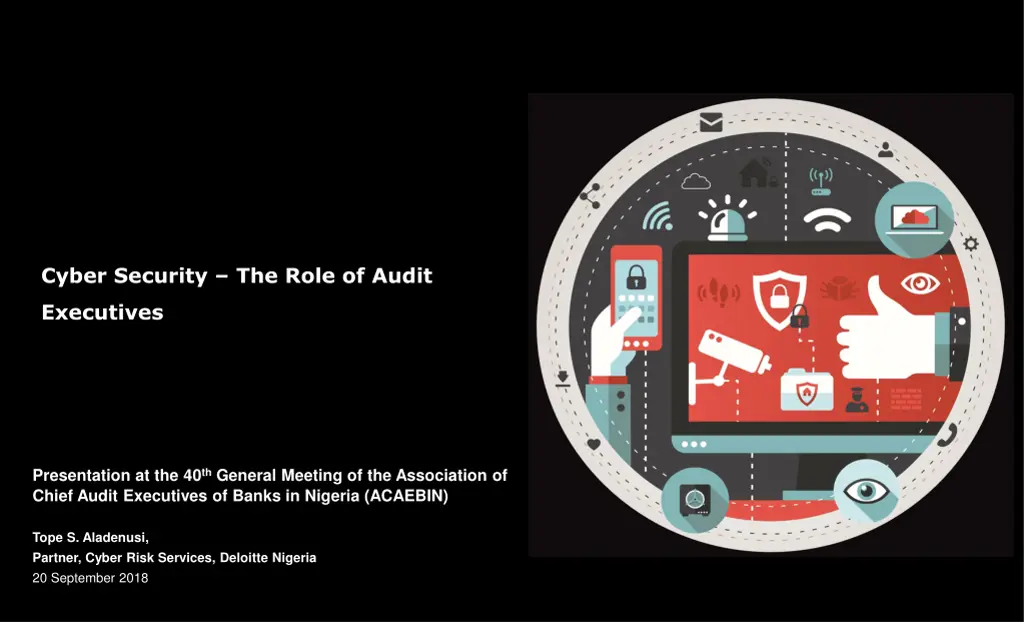
Audit Executives Role in Cyber Security
Learn about the crucial role of audit executives in addressing cyber risks in organizations. Understand the rapid growth of cybersecurity as a top board agenda item, the escalating threat of cyber attacks, and the importance of effective risk evaluation and management. Discover the readiness challenges faced by internal audit teams in addressing cybersecurity risks in the banking sector of Nigeria.
Download Presentation

Please find below an Image/Link to download the presentation.
The content on the website is provided AS IS for your information and personal use only. It may not be sold, licensed, or shared on other websites without obtaining consent from the author. If you encounter any issues during the download, it is possible that the publisher has removed the file from their server.
You are allowed to download the files provided on this website for personal or commercial use, subject to the condition that they are used lawfully. All files are the property of their respective owners.
The content on the website is provided AS IS for your information and personal use only. It may not be sold, licensed, or shared on other websites without obtaining consent from the author.
E N D
Presentation Transcript
Cyber Security The Role of Audit Executives Presentation at the 40th General Meeting of the Association of Chief Audit Executives of Banks in Nigeria (ACAEBIN) Tope S. Aladenusi, Partner, Cyber Risk Services, Deloitte Nigeria 20 September 2018
Cyber Security is a Rapidly Ascending Board Agenda Item With the rapid technology advancement, organizations are exposed to cyber risks now more than ever. Audit committees and board members world wide are seeing cybersecurity as a top risk, underscored by recent headlines and increased government and regulatory focus The forces driving growth and efficiency may create a broad attack surface Technology expansion Technology becomes more pervasive Evolving business models Changing business models Data growth Cybersecurity More data to protect Motivated attackers Threat actors with varying motives Sources: Deloitte Thought Leadership Materials 1
Cyber Risks Top the List Cyber Attacks top the list of man-made attacks, closely following natural disasters. The survey was conducted with respondents worldwide who assessed the potential risks for their impact and likelihood over a 10 year period. Source: World Economic Forum Global Risks Perception Survey 2017 2018. 2
Risk Evaluation The Buck Stops Here Effective risk management is the product of multiple layers of risk defense. Internal Audit should support the board s need to understand the effectiveness of cybersecurity controls. Incorporate risk-informed decision making Define risk appetite and escalate risks outside of tolerance Mitigate risks, as appropriate 1st Line of defence business and IT functions 2nd Line of defence information and technology risk management function Establish governance and oversight Set risk baselines, policies, and standards Implement tools and processes Monitor and call for action, as appropriate 3rd Line of defence Internal Audit Independently review program effectiveness Provide confirmation to the board on risk management effectiveness Ensure that regulatory requirements and disclosure obligations for cybersecurity risks are met Sources: Deloitte Thought Leadership Materials 3
Are Our Internal Audit Teams Ready for The Future ? Today s Audit programs are facing myriad of challenges in being able identify, monitor and report the Cyber Security risks facing the Banks in Nigeria Constant need for skills upgrade Audit Plans not reflecting continuous audit needs Auditor seen as Police, not as Pal Cyber Security risks not given adequate priority in Audit reporting Inadequate monitoring of audit remediation Sources: Deloitte Thought Leadership Materials 4
Transforming Cyber Defenses CAEs Role Cybersecurity is a business issue as it exceeds the boundaries of IT, and cyber risk needs to be managed with as much discipline as financial risk. The 5 pronged approach to achieve that is: Is in place, Is comprehensive and aligns with the Bank s goals Cyber Strategy Ensure that adequate controls, risk management, and remediation Framework Participate and understand the Governance, Policies, Processes, Procedures, investments, support the development of executive- led cyber risk program Perimeter defenses, identity management, and data protection, access controls, antivirus, DLP, WAF, NAC, etc. Secure Resilient Incident response protocols, forensics, and business continuity and disaster recovery plans Ensure that incident response protocols are in place, business continuity, testing and reporting Vigilant SIEM, DAM, Threat Intelligence, security monitoring, and behavioral and risk analyses Ensure that adequate threat intelligence, detection mechanisms, and early remediation is in place Sources: Deloitte Thought Leadership Materials 5
Evolution or Irrelevance? Audit Teams are at a Cross Road Some concerns that the Audit Committees will need to ensure to stay relevant and dynamic include; Chief Audit Executives (CAE)s recognize the need for change Dynamic reporting is poised to increase Internal Audit needs more impact and influence Innovation is key to meeting the demands ahead Gaps in skills must be addressed Reviews of strategic planning and risk management will increase. Use of alternate resourcing models will expand Stable Internal Audit budgets may present challenges Embracing Cyber Security Internal Audit to address increasing cyber risks Embracing Analytics presents major opportunities 6
Thank You The views and opinions expressed in this presentation are those of the author and do not in any way represent the views of the author s employer. You should not act upon the information contained in this publication without obtaining specific professional advice. No representation or warranty (express or implied) is given as to the accuracy or completeness of the information contained in this publication. The author does not accept or assume any liability, responsibility or duty of care for any consequences of you or anyone else acting, or refraining to act, in reliance on the information contained in this publication or for any decision based on it. 7


